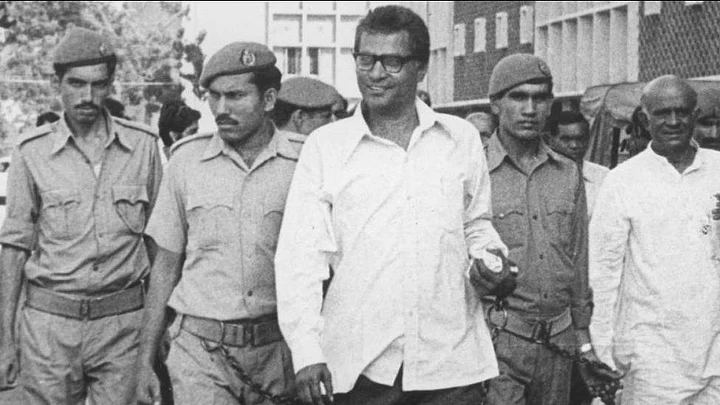(This article was first published on 29 January 2019. It has been reposted from The Quint’s archives to mark the death anniversary of George Fernandes.)
It had been a few hours since the country woke up to the news of George Fernandes’ death, and at the clergy house in Bengaluru’s Bishop House, a retired priest had sat down for lunch. For 86-year-old Fr Anthappa, hearing is a challenge, so, those around him had to shout several times to inform him that his senior from the St Peter’s seminary had passed away.
But, confined to his retired life and challenged by his fading memory, Fr Anthappa was under the impression that George Fernandes had been dead for several years. So, when the news was broken to him his response was a mere “Oh.”
Too busy to read? Listen to the story instead.
Before his days as the firebrand socialist leader, between 1946 and 1948, the former Defence Minister was studying at the seminary to become a Roman Catholic priest. But within the walls of the seminary, where obedience was sacrosanct, young George was a rebel.
“He was an individualist because he never conformed to the rules of the seminary,” said Anthappa. Soon, he left the seminary rebelling against its undemocratic ways – a decision that influenced Indian politics.
Even though a powerful politician with a pan India image, in his home state, George Fernandes leaves behind the legacy of a man from corridors of a seminary transformed into a leader of an underground movement against the Emergency.
The Rebel in the Seminary
According to George Fernandes’ younger brother Michel, what transpired at the seminary reflected who his brother was – an idealist who couldn’t stand injustice. When he realised there was differential treatment for the influential priests and the young students, young George decided to raise his voice.
Anthappa, even though not aware of the reasons why young George left the seminary, knew he was indifferent to the rules. “As young seminarians we were obedient to the rules, but he wasn’t.”
After George left the seminary, Anthappa keenly followed the rise of his senior as a prominent political leader, but never tried to contact him. “We feared being suspected of association,” he said.
But according to the officials at the seminary, years after becoming a minister, in the late 90s, George Fernandes came to the seminary to hoist the flag during one of the Independence Day celebrations.
Plan to Bomb Vidhan Soudha
After leaving the seminary, George Fernandes went back to his hometown in Mangaluru, where he came in touch with Placid D'Mello, a union leader from Mumbai. This kicked off his political journey.
In the years that followed, George Fernandes made it clear that he was far from the obedient servant of God that he wanted to be in the 1940s. While organising an underground movement during the Emergency, he had even convinced Jnanpith awardee UR Ananthamurthy to place a bomb in Vidhan Soudha, Karnataka’s Legislative Assembly.
In a story in his memoir ‘Suragi’, Ananthamurthy explained that it all started with a letter he received. Apart from some criticism of his work, the letter said, “Come and meet me at once.”
Sensing the letter was from George Fernandes – by then a wanted leader of the underground movement – Ananthamurthy took the letter to his friends, Pattabhirama and Snehalata Reddy, who were close to Fernandes. And then began a blindfolded, 45-minute-long car journey to a decrepit church.
“George was sitting on a cot,” Ananthamurthy wrote in his memoir. “He was unrecognisable. He had grown his hair and beard long. I went up to him and touched him. He embraced me.”
Then, a plan was explained to Ananthamurthy: they had identified a rarely used lavatory in Vidhan Soudha, where Snehalata would plant a bomb. The plan was not to kill anyone but to awaken the government. Ananthamurthy’s role was to help Snehalata in planting the bomb and ensuring no one was around.
However, a policeman was posted near the toilet and they had to drop the plans, wrote Ananthamurthy.
Paying the Price for His Rebellion
While Ananthamurthy lost touch with the underground movement, George Fernandes continued on. But over the years, his activism cost him dearly. Snehalata, who was a long-term associate of his in Bengaluru, became one of the first to die following imprisonment during Emergency – for providing Fernandes shelter.
While Fernandes was underground, Snehalata was constantly in touch with him. The police soon tracked her and arrested her on 2 May 1976, alleging her involvement in the Baroda dynamite case.
She spent more than nine months in jail even though she was never chargesheeted in the case. However, the alleged torture in Benagluru jail for information on George Fernandes and his underground movement, deteriorated her health. She was released on 15 January 1977, but five days later she died due to lung infection.
In the post Emergency days, Fernandes was a different man. Although he was perceived to be an alternative to the BJP and the Congress, he went with the BJP claiming it to be the extension of his anti-Congress views.
The reward for his sacrifices during the emergency was the political power that George Fernandes gained, but his decision to support the BJP and the NDA, resulted in several of his old comrades in Karnataka alienating him.
But there is something all agree on – that he is the only truly national leader from Karnataka to this day. His journey from Mangaluru to Mumbai’s political landscape, and then emerging as a tall leader in Bihar, gave him credentials no politician had achieved earlier.
(At The Quint, we question everything. Play an active role in shaping our journalism by becoming a member today.)
